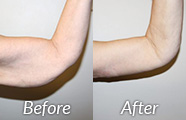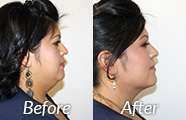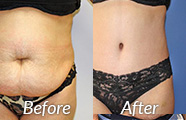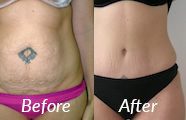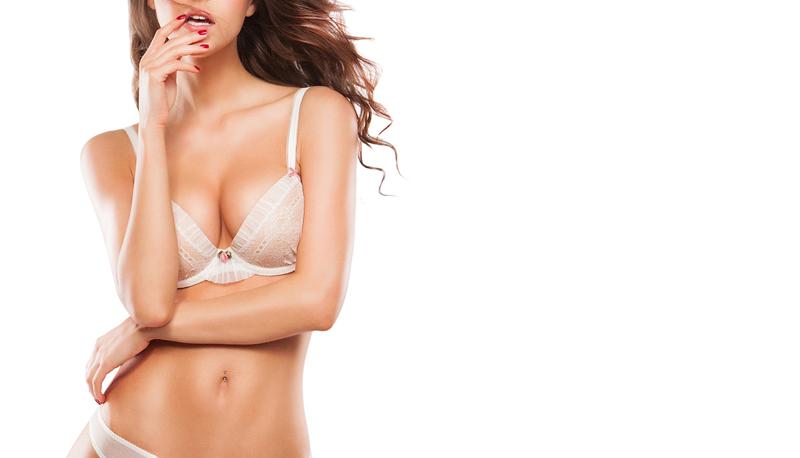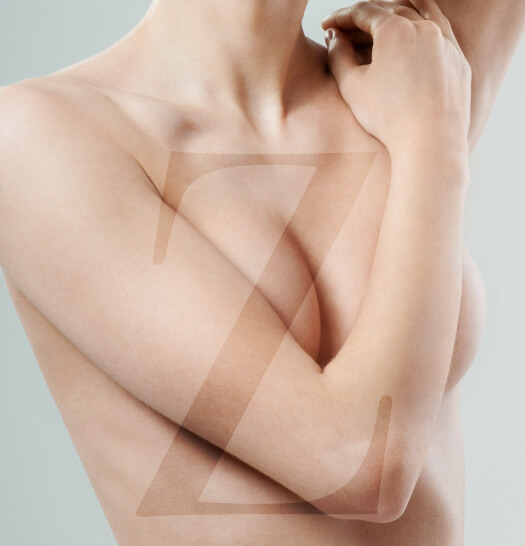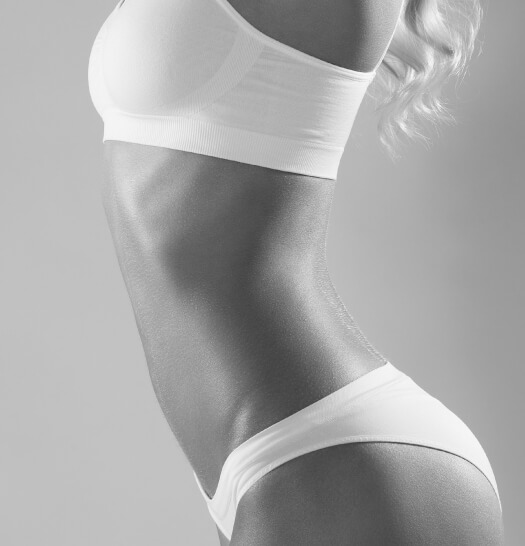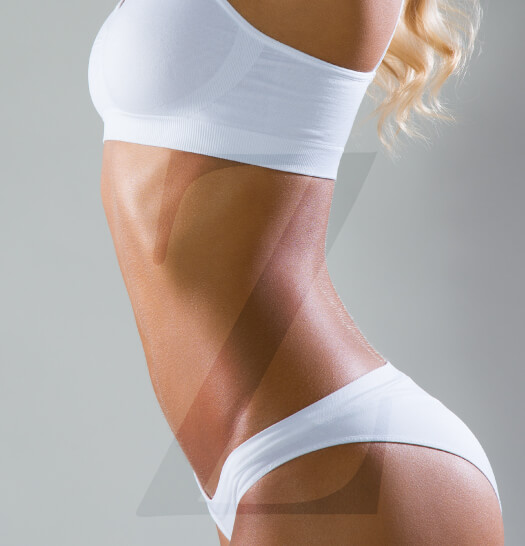Bottoming Out Implant Correction
Conveniently located to serve the areas of Santa Monica, Beverly Hills and Greater Los Angeles
A bottoming out implant correction is a procedure to elevate the positioning of breast implants to restore a more natural appearance. “Bottoming out” is a breast augmentation complication in which the implants descend, creating a drooping effect and more volume in the lower half of the breast. When an implant bottoms out, it also makes the nipples look more raised on the breast mound.
Although this issue can happen to both augmented breasts, it more often only occurs in one and causes asymmetry as well. Pain and discomfort are not common, but they can occur due to a downward stretch of the skin. The condition usually develops with larger implants or breast tissue that is too thin or weak to hold the implant properly. It usually leaves patients feeling uncomfortable and disheartened by the look of their breasts, making them feel the need to cover up. Luckily, revision surgery can easily repair these defects through implant exchange and revision to the breast pocket.
To get a thorough evaluation to see if your breast implants are displaced, schedule your consultation at Zarrabi Plastic Surgery in Santa Monica or Beverly Hills. Dr. Michael Zarrabi, a board-certified surgeon, has extensive training in balancing their technical skill with their artistic vision to create excellent results. Dr. Zarrabi has a presence within the media, making him a prominent leader within his fields of expertise.
We invite you to schedule your appointment by calling (310) 584-9990 or inquiring with our contact form, and we will happily assist you in finding a date and time that works best.
Contents
What Causes Bottoming Out?
Bottoming out is primarily caused by a weakening of the inframammary fold just under the breast. Usually, there is no one reason for this occurring, but it has to do with a combination of surgical factors and the quality of the breast tissue itself. Some patients do not have good skin elasticity, so the breast is unable to accommodate large implants, and gravity pulls them downward over time. Pregnancy, weight fluctuations, and the natural aging process can contribute to the changes in the breast ducts and lobules, causing the implant to place more pressure. Women who receive implants to correct tuberous breasts, those with nipples that are somewhat closer to the inframammary fold, and women who received their implants with a transaxillary technique are all at higher risk of experiencing bottoming out. Studies also find that implants in the subglandular plane (over the chest muscles) and smooth implants are also more likely to descend unnaturally. (1)
“Double Bubble”
Some patients confuse bottoming out with “double bubble”- a similar condition that can look extremely similar to bottoming out. With double bubble, the surgeon fails to reform the previous inframammary fold that was present before the procedure. As the large implants begin to descend and push the breast volume downward, the old fold remains, creating the look of two “bubbles” under the breast mound. Luckily, just like bottoming out, double bubble is highly treatable and often require the same approaches.
Breast Sagging
With normal sagging with implants, the breast as a whole migrates downward, but there is more visible stretch on the top half. The nipples also point downward, unlike the upward-pointing nipples characteristic in patients with bottoming out. If you have normal breast sagging, Dr. Zarrabi may recommend a breast lift, but no revision to the implant positioning is required.
Benefits of Bottoming Out Correction
Unnatural-looking breasts should not be something you have to live with. After all, you chose breast augmentation to feel empowered and feminine, not burdened and embarrassed by cosmetic issues. Correction surgery has a range of benefits for you to consider:
- Surgery will restore the harmonious, balanced contours you want to achieve.
- You can exchange your implants for something better suited to your body.
- Revision surgery may cost less than the original procedure if your implants are still under warranty.
- Dr. Zarrabi can correct any other problems, like capsular contracture (the buildup of too much scar tissue), which may be contributing to deformity.
- He will use the same incisions as the previous surgery, eliminating the risk of further scarring.
- He can use advanced surgical techniques to provide more internal support, also known as an Internal Bra within the breast, reducing the chance that unwanted repositioning will occur again.
Personal Consultation
During your consultation with Dr. Zarrabi you will get to discuss your history with your breast implants and the aesthetic/health issues you have been facing. He will take time to evaluate your breast tissues and determine a solution that will not only correct the issue at hand but also prevent other deformities. He will make sure that you have a thorough understanding of the preparation required, the procedural techniques, and the recovery. He will also assess your overall health and any conditions you may have to see if you can safely undergo surgery.
To request a comprehensive evaluation, visit Zarrabi Plastic Surgery in Beverly Hills or Santa Monica, go online, or call one of our offices at (310) 584-9990.
Preparation
You should prepare for your bottoming out correction procedure in the same way you would prepare for a breast augmentation. First, you should speak with Dr. Zarrabi about your medications and supplements and make any necessary adjustments to ensure a complication-free surgery and recovery. If you smoke cigarettes or other nicotine products, you should aim to stop a few weeks before your scheduled procedure date; making this vital change will allow you to heal faster due to improved blood circulation. Pick up any required prescriptions and make a plan with a friend or family member to pick you up after your procedure. You will want to get someone to help you on the first day. Finally, you should begin fasting around 12 hours before your surgery.
Procedure Steps
After your anesthesiologist administers general anesthesia, Dr. Zarrabi will begin by utilizing the same incisions as your previous implant procedure. This means making either a periareolar incision (around the areola) or a small inframammary incision where the bottoming out is most noticeable.
Breast Capsulorrhaphy
After making the incision, Dr. Zarrabi will perform a capsulorrhaphy which they will complete in a few steps. Depending on your needs, they may only need to perform some of these steps:
- Implant removal. If there is a breast implant leakage or another health issue, Dr. Zarrabi may remove the implant and the surrounding scar tissue capsule as one piece, a technique called an en bloc capsulectomy. If there are no issues present, they may keep the capsule in the breast pocket.
- Breast pocket revision. Dr. Zarrabi will reform the breast pocket by strategically widening it, closing it with sutures, or shrinking the pocket. One of the most effective ways of shrinking the breast pocket is through a popcorn capsulorrhaphy technique, a modern method founded in 2009 and further improved in 2018. For “popcorning” the breast pocket, he will use precise thermal energy to contract the tissues. (2)
- Implant replacement. He will cleanse the breast pocket and place new, smaller implants inside, ensuring that it fits correctly.
- Breast lift. To encourage better breast elevation, Dr. Zarrabi will remove excess skin with a breast lift.
- Inframammary fold suturing. He will suture the inframammary fold to provide the most supportive structure for the new implants.
- Internal bra. Finally, Dr. Zarrabi will place an “internal bra” made of a portion of biocompatible mesh to further support the new implant. Sometimes, this is not necessary, but it can serve as an excellent scaffold for weaker implant capsules.
- Final sutures. He will close all incisions using a layered technique to allow the revised tissue to heal correctly.
Recovery and Results
A breast capsulorrhaphy is tailored to your needs, so the recovery will vary from patient to patient. This procedure is typically less intensive than the initial breast augmentation procedure, so you can expect a somewhat quicker recovery. You will experience temporary swelling, tenderness, and bruising, but he will provide you with the guidance and medication you need for a healthy recovery. These symptoms may last for a few weeks, but you will be comfortable enough to return to a sedentary job after just a few days.
Though you will be mostly recovered after 1 to 2 weeks of downtime, you should refrain from strenuous activities for at least 3 to 6 weeks, or until your surgeon deems it safe. You should partake in light walks to encourage blood flow throughout your body. Dr. Zarrabi will provide you with more information regarding the use of a compression bra, lymphatic massage to encourage the reduction of swelling, and other tips for recovery. The results of your capsulorrhaphy should last as long as your implants, which may be 10 to 15 years or more, depending on how your body adapts to the implants over time. Some surgeons find that breast implants are durable enough to last 20 years without requiring replacement. (3)
Cost of Bottoming Out Implant Correction in Beverly Hills
The cost of bottoming out implant correction will depend on the anesthesia fees, surgical techniques, medication, other surgical fees, and any follow-up appointments you may schedule at Zarrabi Plastic Surgery. Dr. Zarrabi will discuss all of these factors at the time of your consultation. If interested, please consider applying for one of our financing options with CareCredit, allowing you to make affordable payments over time.
To further discuss your options for breast implant revision, call (310) 584-9990 to reach our locations in Santa Monica and Beverly Hills. You can also ask us a question or request an appointment with one of our highly skilled surgeons with our online form. We cannot wait to introduce you to the innovative approaches that will leave you with more body confidence than ever before.
References
- Denney BD, Cohn AB, Bosworth JW, Kumbla PA. Revision Breast Augmentation. Seminars in Plastic Surgery. 2021;35(02):098-109. doi:https://doi.org/10.1055/s-0041-1727272
- Awaida CJ, Paek L, Danino MA. A New Technique for Breast Pocket Adjustment: Argon Beam Thermal Capsulorrhaphy. Plastic and Reconstructive Surgery – Global Open. 2022;10(7):e4437. doi:https://doi.org/10.1097/gox.0000000000004437
- Fardo D, Sequeira Campos M, Pensler JM. Breast Augmentation. PubMed. Published 2021. https://www.ncbi.nlm.nih.gov/books/NBK482206/#:~:text=The%20risk%20of%20complications%20is


